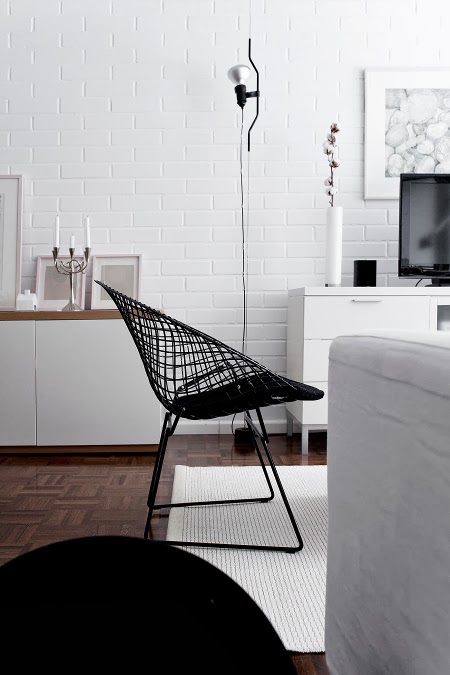 |
| Tattoo Stools and Branchmark Table / Gerd Wingårdh and Sara Helder |
Sotien myrskyissä yritys jouduttiin välillä sulkemaan, mutta toimintaa jatkettiin heti, kun se oli taas mahdollista. Koko vaiherikkaan tarinan voi lukea täältä; minä sen sijaan oikaisen suoraan nykyhetkeen ja tulevaisuuteen katsovaan yritykseen, joka pyrkii toimistusjohtaja Orhan Niksicin johdolla määrätietoisesti yhdistämään perinteistä käsityötaidoa moderniin muotoiluun ja luomaan työpaikkoja korkeasta työttömyydestä kärsivään maahan. Myös ekologisuus ja kestävä kehitys ovat yritykselle ensisijaisen tärkeitä arvoja.
Ihailen tällaisia perheyrityksiä, jotka eivät tarraudu liiaksi menneisyyteen, mutta osaavat kuitenkin käyttää omia vahvuuksiaan ja luoda niiden avulla muista poikkeavia tuotteita. Zanatin huonekaluissa kaiverrustekniikalla on yhä tärkeä rooli, vaikka muotokieli ja toiminnallisuus ovat tätä päivää.
Hyvä esimerkki on ruotsalaisten Gerd Wingårdhin ja Sara Helderin suunnittelema, yhtä lailla kotiin kuin toimistoon sopiva Tattoo-jakkara, joka on kolmi- tai nelijalkainen, pinottava, siro ja helposti liikuteltava. Jakkaraan on tarjolla erityylisiä koristeaiheita, jotka on ikään kuin tatuoitu puuhun kaivertamalla ja nostettu esiin värjäämällä, mutta sen saa myös täysin yksivärisenä.
Upeasti kaiverrustekniikkaa hyödyntää myös Harri Koskisen suunnittelema viinikaappi Vinco, jonka sisällä on kylmäsäilytystilaa ja paikat pulloille ja viinilaseille. Oma suosikkituotteeni taitaa kuitenkin olla alimman kuvan Monica Försterin palkittu Unna-tuoli, jonka selkänoja näyttää muotonsa ansiosta kauempaa melkein pehmusteltulta ja kaiverrukset ovat kuin niittejä, joilla kangas on kiinnitetty paikoilleen.
Mitä te tykkäätte tällaisesta perinteisen käsityötekniikan ja uuden muotoilun yhdistelystä? Iskeekö tatuoitu jakkara vai houkuttaako enemmän Harri Koskisen Igman-nojatuolin syli?
(IT) Studioilse, Monica Förster, Harri Koskinen - ecco alcuni dei designer che collaborano oggi con Zanat che viene dalla Bosnia ed Erzegovina. L'azienda familiare quasi centenne proviene dalla città di Konjic dove il bisbisnonno Gano della famiglia Nicsik ha scoperto l'arte dell'incisione del legno. Suo figlio Adem ha cominciato a vendere mobili decorati con questo metodo e ha avuto così tanto successo che anche altri laboratori del legno sono stati aperti nella zona. Ora lo stile dei mobili e la tecnica dell'incisione sviluppati sono noti come stile Konjic bosniaco.
A causa delle guerre l'attività è stata chiusa varie volte ma ha riaperto di nuovo appena possibile. Tutta la storia si può leggere qui ma io faccio un salto e arrivo direttamente alla ditta di oggi che sotto la direzione di Orhan Niksic guarda verso il futuro e cerca di unire l'arte artigiana con il design moderno per creare lavoro nel paese che soffre di un alto livello di disoccupazione. Anche i valori ecologici sono molto importanti per quest'impresa.
Io ammiro questo tipo di aziende familiari che non si attaccano troppo al passato ma sanno comunque sfruttare i propri punti di forza per creare prodotti che si distinguono dagli altri. Nei mobili di Zanat la tecnica di incisione ha ancora un ruolo importante anche se il design e l'usabilità si conciliano con gli standard di oggi.
Un buon esempio è lo sgabello Tattoo che si adatta sia per ambienti domestici che per uffici, progettato dagli svedesi Gerd Wingårdh e Sara Helder, che ha tre o quattro gambe, è impilabile, grazioso e facile da spostare. Le decorazioni in stili diversi sembrano tatuate sul legno e risaltano ancora di più grazie all'aggiunta di colore. Lo sgabello è però disponibile anche in versione semplice senza decoro.
Anche l'armadio per vini Vinco di Harri Koskinen utilizza in modo elegante la tecnica dell'incisione e contiene sia uno frigorifero sia spazio per bottiglie e bicchieri. Penso che il mio preferito sia comunque la premiata sedia Unna di Monica Förster. Visto da lontano, lo schienale sembra quasi imbottito e le incisioni sono come delle graffette utilizzate a fissare la stoffa.
Cosa ne pensate di questo tipo di abbinamento di una tecnica antica a un design moderno? Vi piace lo sgabello tatuato o vi sembra più invitante la poltrona Igman di Harri Koskinen?
 |
| Vinko Wine Cabinet / Harri Koskinen |
During the wars the business was forced to close but it was reopened again as soon as possible. You can read the whole story here but I now jump to the current situation and the company that with Orhan Niksic as their CEO looks forward and combines traditional handicraft skills with modern design, trying to create workplaces in a country with high unemployment rates. Also the sustainability is an important value to the company.
I admire this kind of family businesses that are not too attached to the past but still use their strengths in order to create products that aren't similar to others. The carving technique is still an important feature in the Zanat furniture even though their design and usability follow today's standards.
A good example is the Tattoo stool by Swedish Gerd Wingårdh and Sara Helder, suitable for home or office spaces as well, that has three or four legs, is stackable, light and easy to move. There are different decor motives available that are like tattooed to the wood and highlighted by colour but you can also have the stool without any decoration.
The carving technique is used beautifully also in the Vinco wine cabinet by Harri Koskinen. Inside the cabinet there's space for cooling wine and storing bottles and wine glasses. I think my favourit product is anyhow the prize-winning Unna chair by Monica Förster. The back rest looks as if it were upholstered and the carving seems like staples used for attaching the fabric.
What do you think about this kind of a combination of traditional handicraft and modern design? Do you like the tattooed stools or does the Igman armchair by Harri Koskinen look more inviting?
 |
| Igman Lounge Chair and Ottoman & Bowlkan Table / Harri Koskinen |
 |
| Unna Chair / Monica Förster, this picture © Zanat |








































































































































































































No comments:
Post a Comment